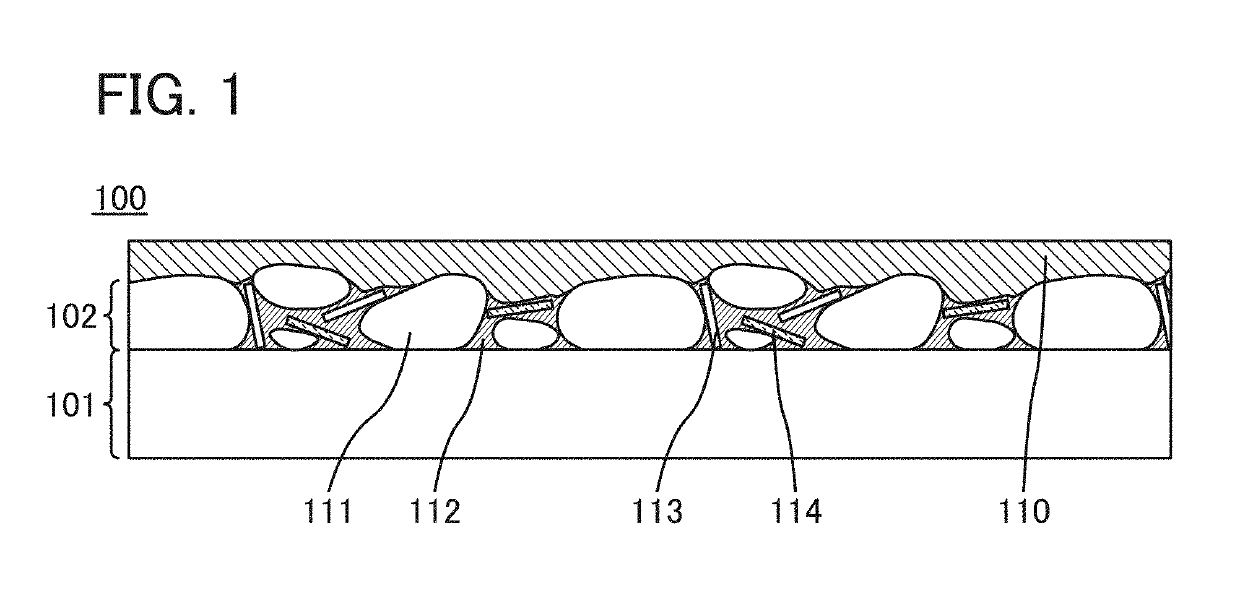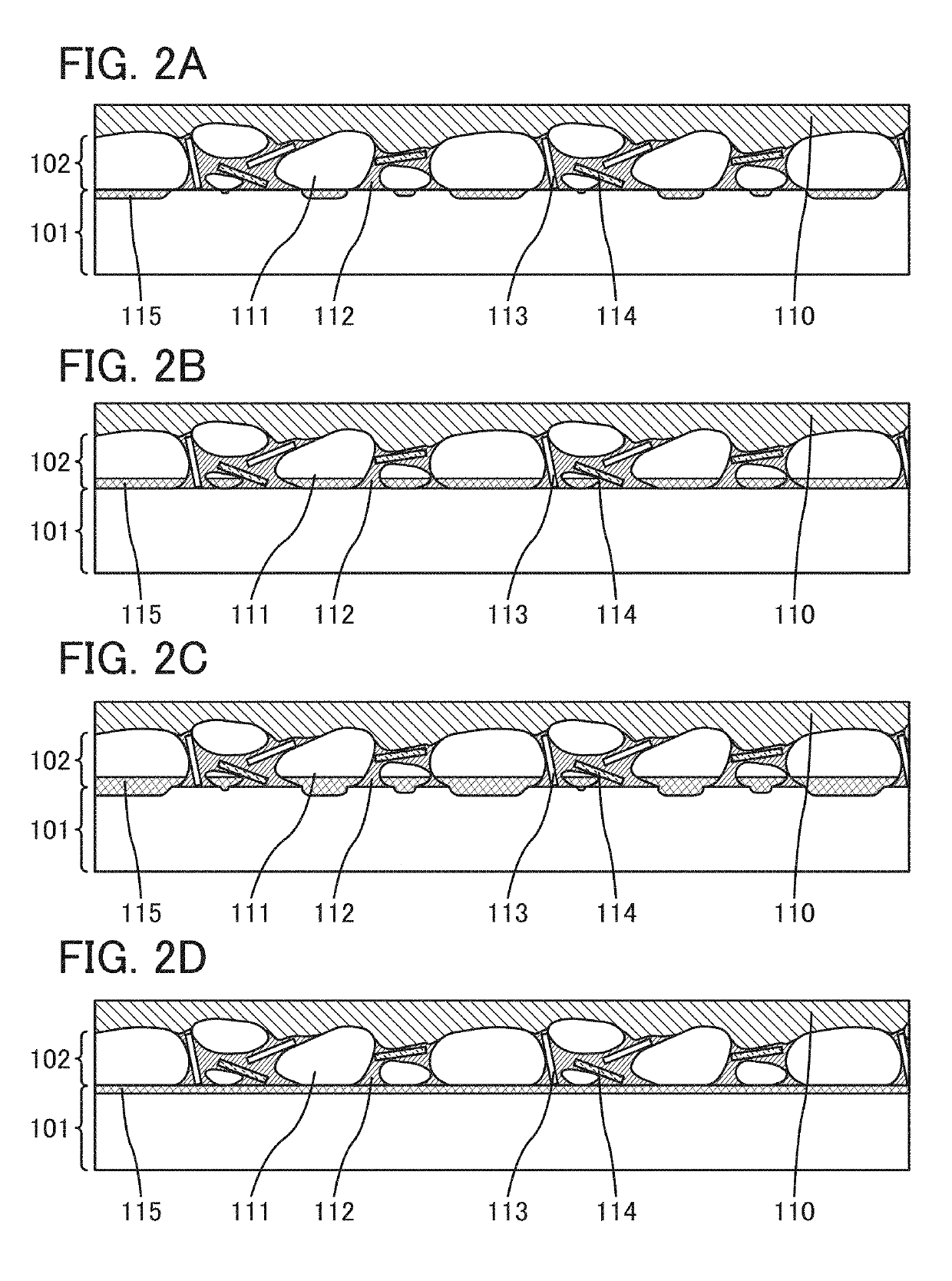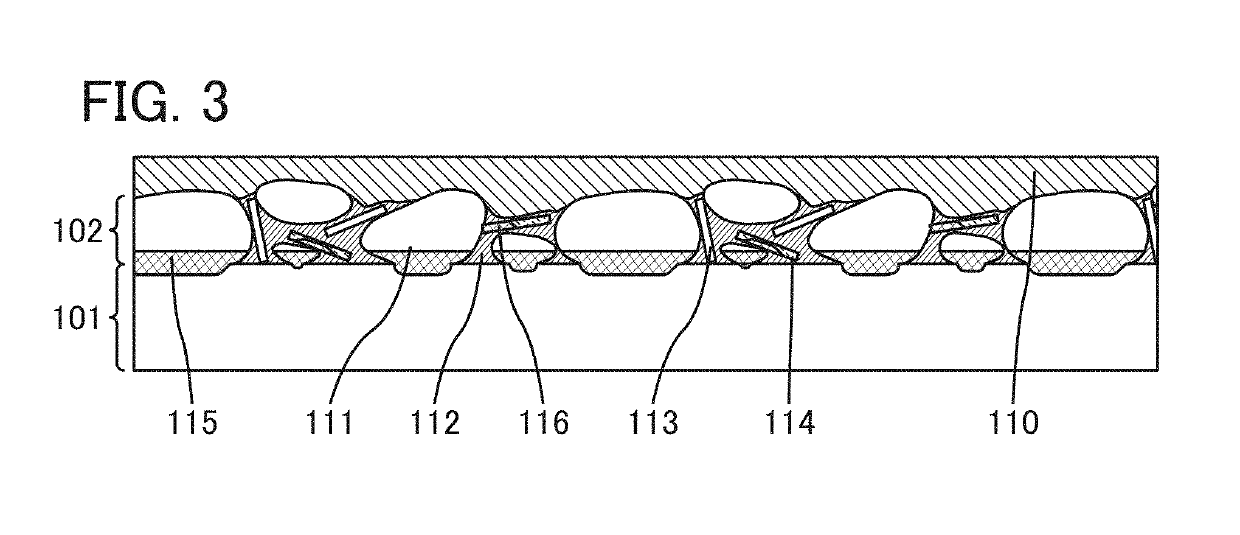Secondary battery
a secondary battery and battery technology, applied in the field of secondary batteries, can solve the problems of deterioration in characteristics of secondary batteries, separation between current collectors, and gradual reduction of contact between active materials, so as to prevent secondary battery deterioration due to deformation, suppress the generation of defects due to expansion and contraction of active materials in negative electrodes, and suppress the effect of charge-discharge cycle characteristics
- Summary
- Abstract
- Description
- Claims
- Application Information
AI Technical Summary
Benefits of technology
Problems solved by technology
Method used
Image
Examples
embodiment 1
(Embodiment 1)
[0064]In this embodiment, a negative electrode of one embodiment of the present invention will be described with reference to drawings.
[Structural Example]
[0065]FIG. 1 illustrates a cross section of a structural example of a negative electrode 100 described below. The negative electrode 100 includes, over a surface of a current collector 101, a negative electrode active material layer 102 and a covering layer 110 that covers the negative electrode active material layer 102. The negative electrode active material layer 102 includes a negative electrode active material 111 and a binder 112. As illustrated in FIG. 1, the negative electrode active material layer 102 may include a conductive additive 113 and a metal flake 114.
[0066]A material containing a metal or alloy having a low melting point (e.g., 250° C. or lower) is preferably used for the negative electrode active material 111. For example, a low melting point metal such as gallium (Ga), mercury (Hg), indium (In), ...
embodiment 2
(Embodiment 2)
[Coin-Type Storage Battery]
[0106]FIG. 7A is an external view of a coin-type (single-layer flat type) storage battery, and FIG. 7B is a cross-sectional view thereof.
[0107]In a coin-type storage battery 300, a positive electrode can 301 doubling as a positive electrode terminal and a negative electrode can 302 doubling as a negative electrode terminal are insulated from each other and sealed by a gasket 303 made of polypropylene or the like. A positive electrode 304 includes a positive electrode current collector 305 and a positive electrode active material layer 306 provided in contact with the positive electrode current collector 305. The positive electrode active material layer 306 may further include a binder for increasing adhesion of positive electrode active materials, a conductive additive for increasing the conductivity of the positive electrode active material layer, and the like in addition to the active materials. As the conductive additive, a material that h...
example 1
[0173]In this example, a negative electrode of one embodiment of the present invention and a secondary battery including the negative electrode were fabricated.
[Fabrication of Sample]
[0174]Powdery gallium, copper flake, VGCF, and a resin (PVDF) were mixed such that the weight ratio thereof was 85:5:5:5. This mixture was kneaded with a planetary kneading machine at 2000 rpm for 5 minutes, NMP (N-methylpyrrolidone) was added thereto, and further mixed for 15 minutes, so that a first slurry is formed. Then, the first slurry was applied to a metal foil containing copper as its main component that is the current collector, kept at 50° C. for 2 hours to vaporize the solvent, and kept at 120° C. for 10 hours.
[0175]VGCF and PVDF, which were separately prepared from the above, were mixed such that the weight ratio thereof was 1:1. This mixture was kneaded with a planetary kneading machine at 2000 rpm for 5 minutes, NMP (N-methylpyrrolidone) was added thereto, and further mixed for 15 minutes...
PUM
| Property | Measurement | Unit |
|---|---|---|
| thickness | aaaaa | aaaaa |
| melting point | aaaaa | aaaaa |
| melting point | aaaaa | aaaaa |
Abstract
Description
Claims
Application Information
 Login to View More
Login to View More - R&D
- Intellectual Property
- Life Sciences
- Materials
- Tech Scout
- Unparalleled Data Quality
- Higher Quality Content
- 60% Fewer Hallucinations
Browse by: Latest US Patents, China's latest patents, Technical Efficacy Thesaurus, Application Domain, Technology Topic, Popular Technical Reports.
© 2025 PatSnap. All rights reserved.Legal|Privacy policy|Modern Slavery Act Transparency Statement|Sitemap|About US| Contact US: help@patsnap.com



